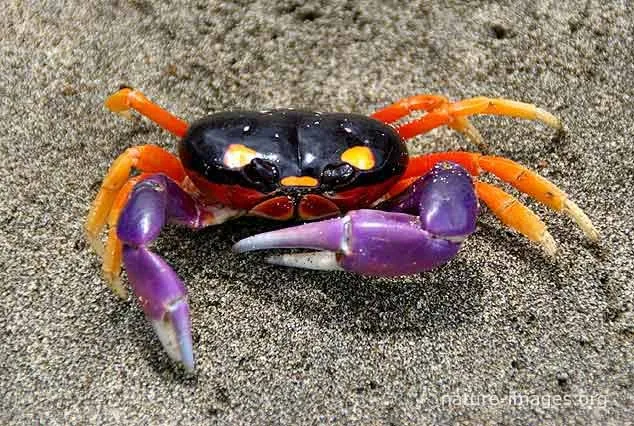The natural world is full of fascinating ecosystems, each playing host to unique wildlife and intricate ecological dynamics. Among these wonders, the Halloween Crab Biome stands out as a vibrant and intriguing environment, home to the brilliantly colored Halloween crab (Gecarcinus quadratus). From its stunning natural beauty to the fascinating species interactions it supports, this biome is a hidden gem worth exploring.
What Is the Halloween Crab Biome?
The Halloween crab biome is primarily found in neotropical coastal rainforests stretching along the west coast of Central America, from Mexico to Ecuador. Characterized by a humid and tropical climate, these rainforests are bordered by the coastline, offering the perfect ecological niche for Halloween crabs.
Halloween crabs are terrestrial creatures that rely on both land and water for survival. They are skilled burrowers living primarily on land, often in nutrient-rich forest floors blanketed with leaf litter. However, their proximity to the ocean is essential, as they migrate to coastal waters for reproduction.
The biome’s defining feature is its mix of dense tropical vegetation, humid soil, and proximity to coastal waters, which sustains the biodiversity that thrives within it. This environment plays a crucial role as a habitat for countless species, including the Halloween crab.
Key Species Interactions in the Halloween Crab Biome
The Halloween crab is a striking inhabitant of this biome, known for its vivid black carapace, orange legs, purple claws, and yellow eye spots that give it its festive name. These crabs are much more than just a visual delight; they perform vital ecological roles that maintain the health of their habitat.
- Nutrient Cycling Through Leaf Litter
Halloween crabs are primarily herbivorous, feeding on leaf litter and plant material. Their feeding and burrowing activities play a significant role in nutrient cycling, helping move nutrients from decaying plant material deeper into the soil. This process supports plant growth and soil fertility, benefiting the entire rainforest ecosystem.
- Prey-Predator Dynamics
While Halloween crabs are generally harmless to humans and non-aggressive, they are prey to various predators found in neotropical rainforests. Birds, larger reptiles, and mammals help regulate Halloween crab populations, ensuring ecological balance within the biome.
- Impact on Reproduction Cycles Along the Coastline
One of the most fascinating aspects of Halloween crab behavior is their mass migration to coastal waters for spawning. This event creates a significant pulse of biomass entering the ocean, benefiting marine creatures that rely on these nutrient surges, including fish and other crustaceans.
Threats to the Halloween Crab Biome
Despite its vibrancy, the Halloween crab biome faces significant threats, largely driven by human activity and environmental changes.
- Habitat Loss
Deforestation and land development pose a severe risk to coastal rainforests. Urban expansion and agricultural activities reduce the forested areas where these crabs build their burrows, leading to habitat fragmentation and population decline.
- Climate Change
Rising temperatures and unpredictable rainfall cycles threaten the delicate balance of the Halloween crab biome. These changes can disrupt the crabs’ breeding patterns, especially their migration to the ocean during the rainy season. Additionally, rising sea levels may infringe upon their coastal breeding grounds.
- Pollution
Pollution, particularly in coastal waters, affects not only the survival of Halloween crab larvae but also the broader marine ecosystem that depends on this biome’s biodiversity.
Conservation Efforts and How to Get Involved
Recognizing the ecological importance of the Halloween crab biome, several conservation initiatives focus on preserving this unique habitat and its inhabitants.
- Protected Areas
Efforts to establish and maintain protected areas within neotropical rainforests are essential for conserving the Halloween crab biome. These reserves safeguard critical habitats from deforestation and human encroachment.
- Community Engagement
Local communities play a vital role in protecting these ecosystems. Organizations often work with indigenous groups and local populations to educate and promote sustainable practices that preserve rainforests.
- Climate Action
Addressing climate change through global initiatives and local actions is crucial for the long-term survival of the Halloween crab biome. Reduced emissions, reforestation projects, and carbon offset programs are key to tackling climate threats.
How You Can Help
Nature enthusiasts, pet owners, and marine biologists can all contribute to protecting the Halloween crab biome in simple yet impactful ways.
- Support Conservation Organizations: Donate to or volunteer with organizations that focus on preserving neotropical rainforests.
- Responsible Travel: When visiting coastal rainforests, practice eco-tourism by minimizing your environmental footprint and supporting local conservation projects.
- Spread Awareness: Educate others about the fascinating Halloween crab biome and the need to protect it. Share information online or through community outreach to inspire action.
A Biome Worth Protecting
The Halloween crab biome is a breathtaking and essential part of our planet’s ecological tapestry. From its unique climate and species interactions to the vital ecological roles played by creatures like the Halloween crab, this biome deserves both fascination and protection. Its survival hinges on collective efforts to conserve coastal rainforests, mitigate climate change, and encourage global awareness.
Are you ready to make a difference? Whether through supporting conservation efforts or spreading awareness, you have the power to help protect both the Halloween crab and the remarkable biome it calls home. Nature’s diversity thrives when we act with purpose, and the Halloween crab biome is no exception.








